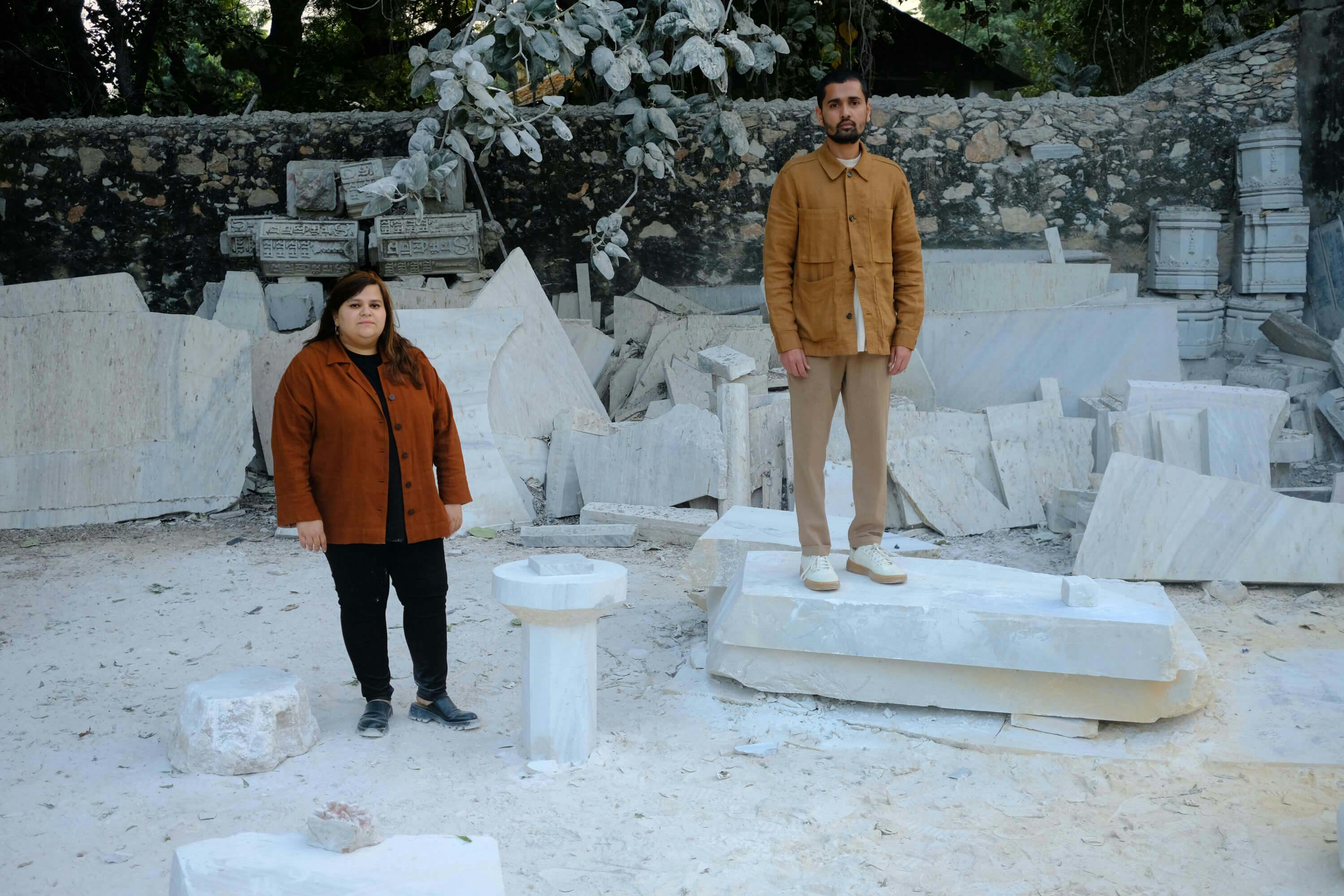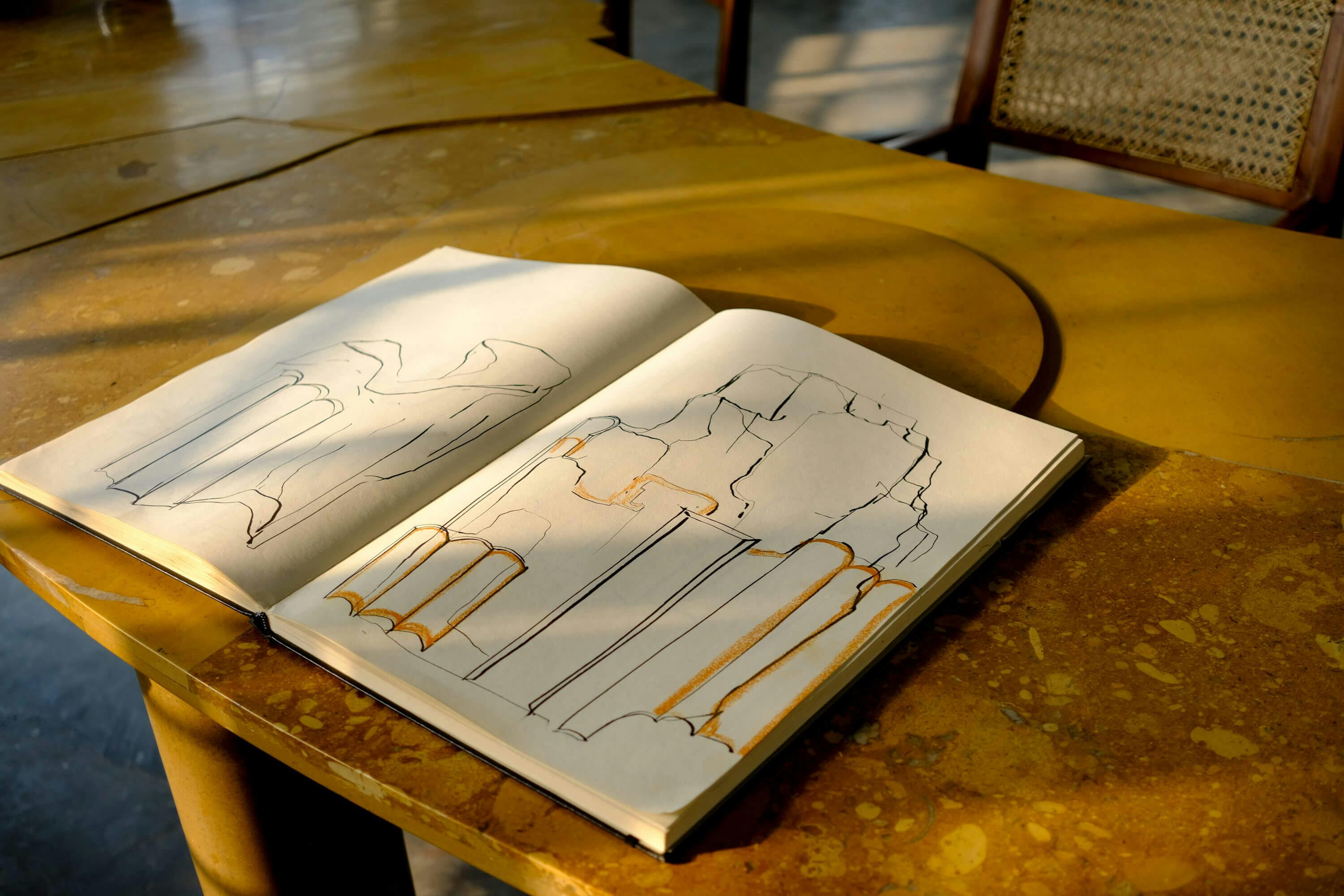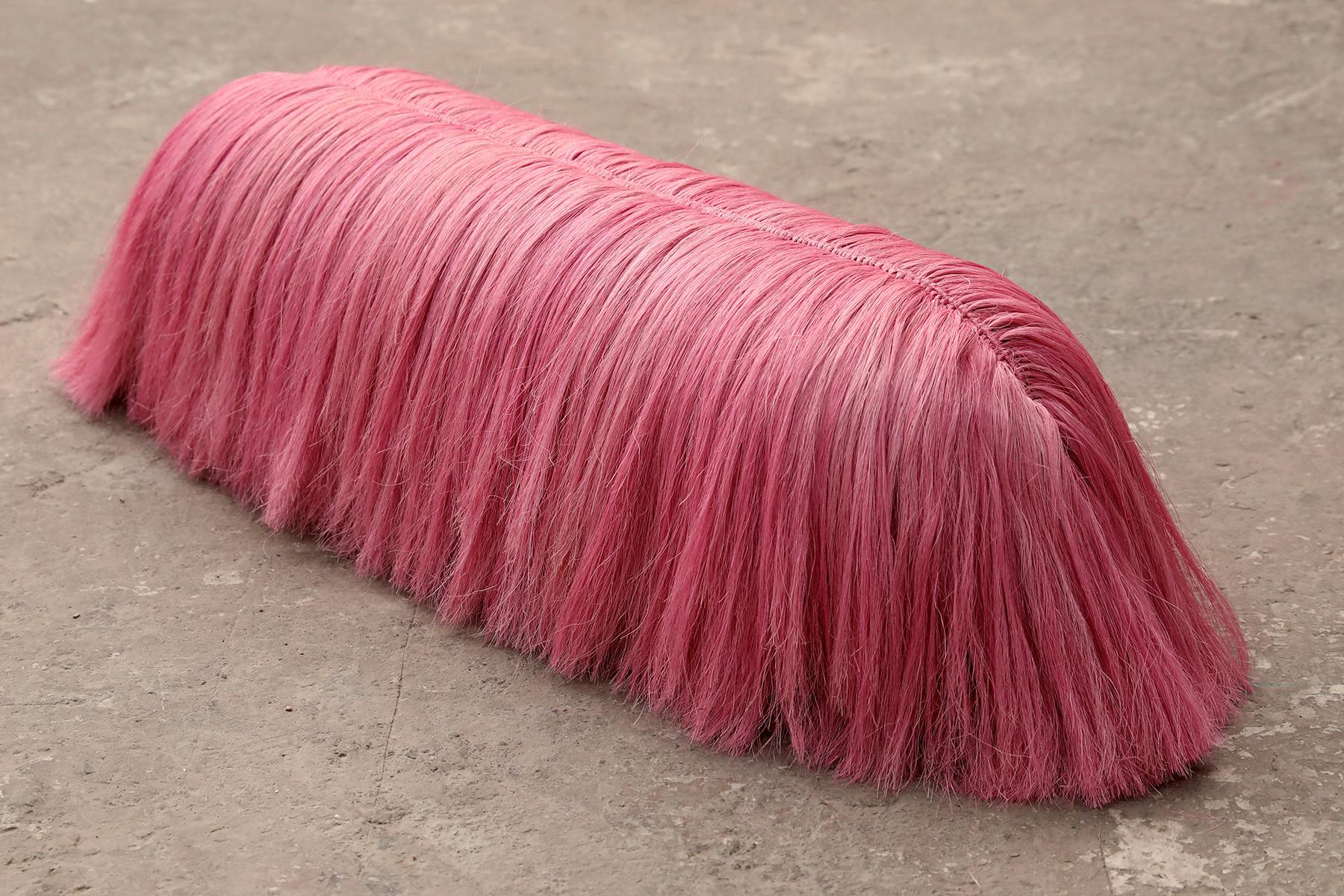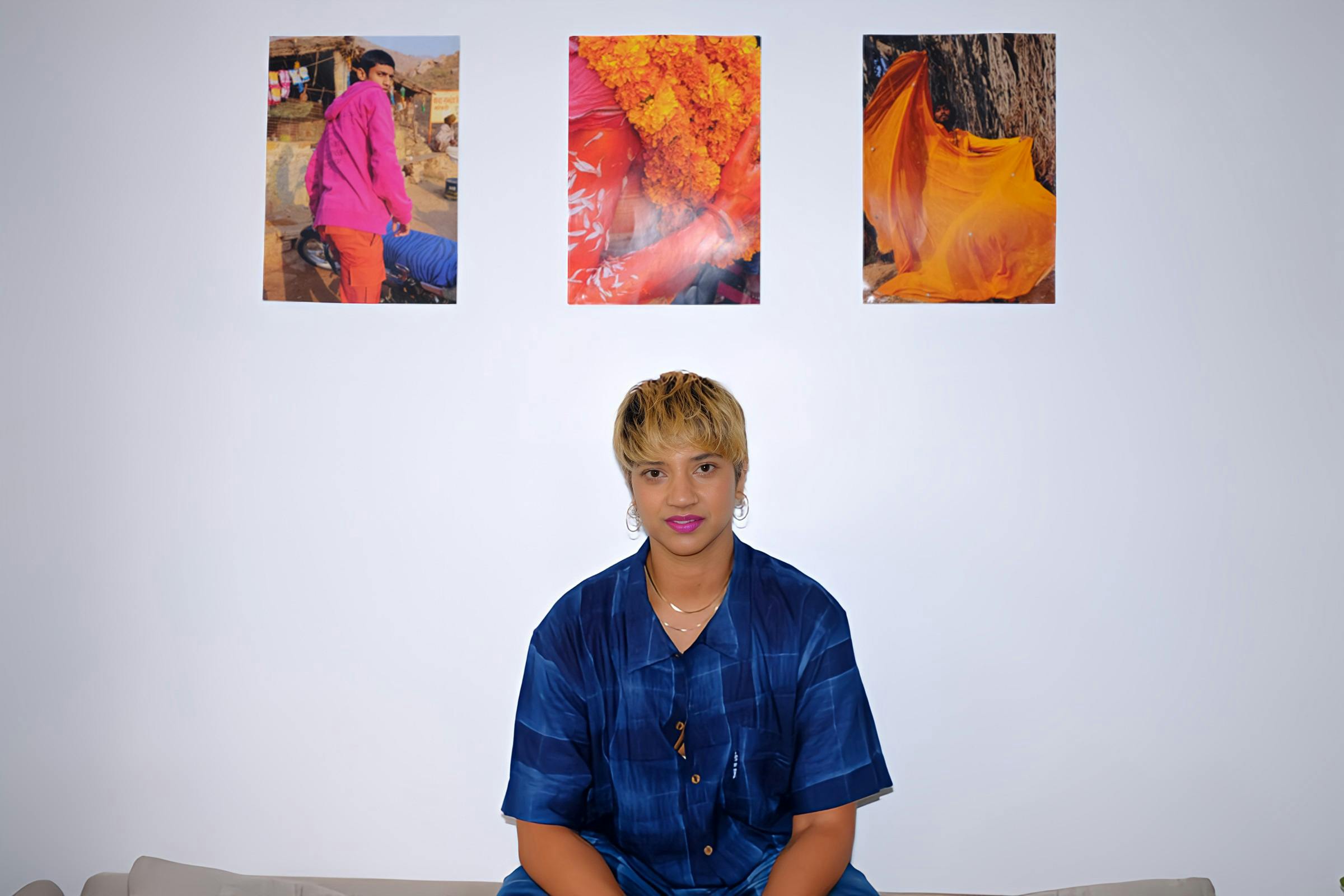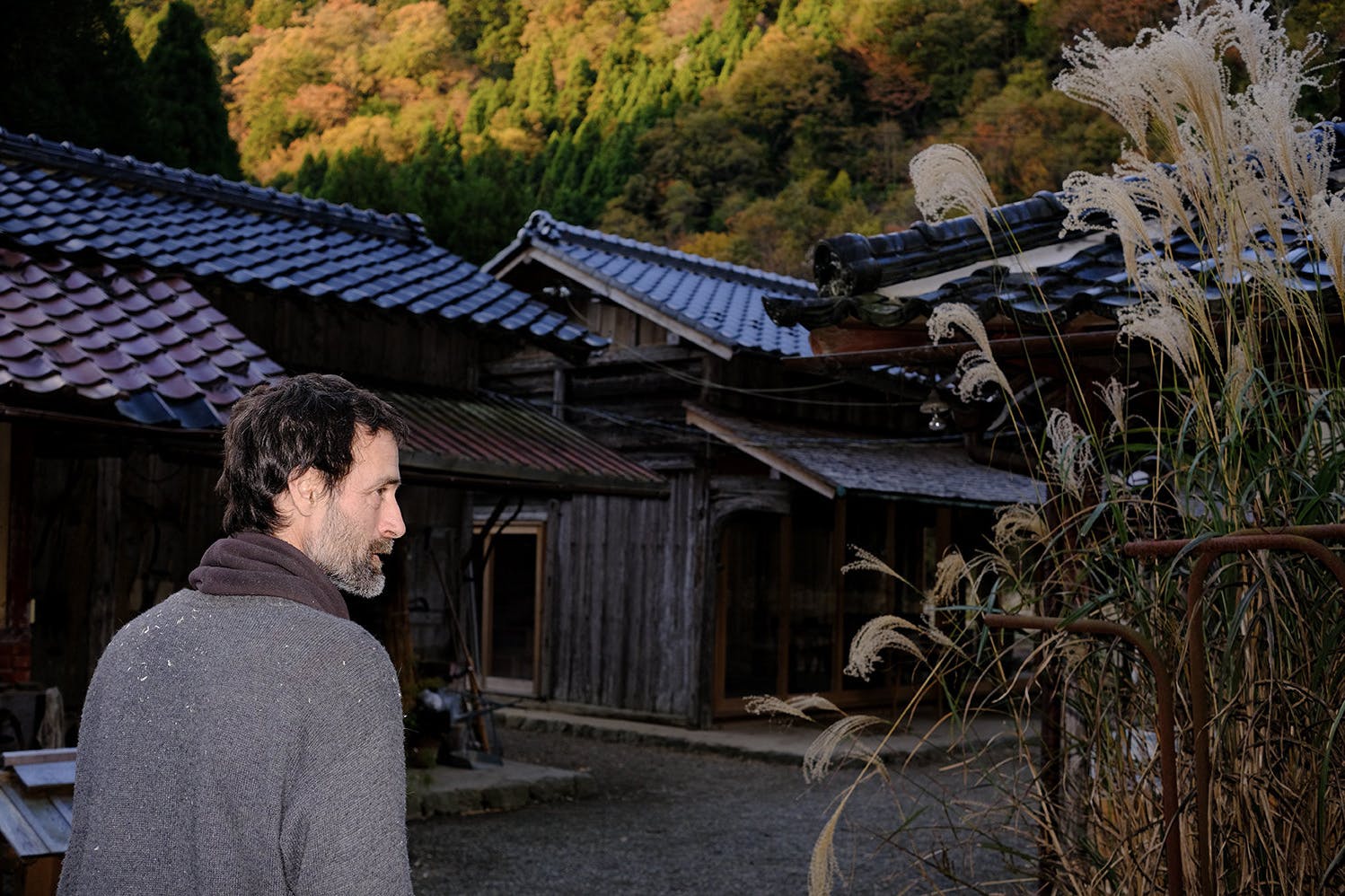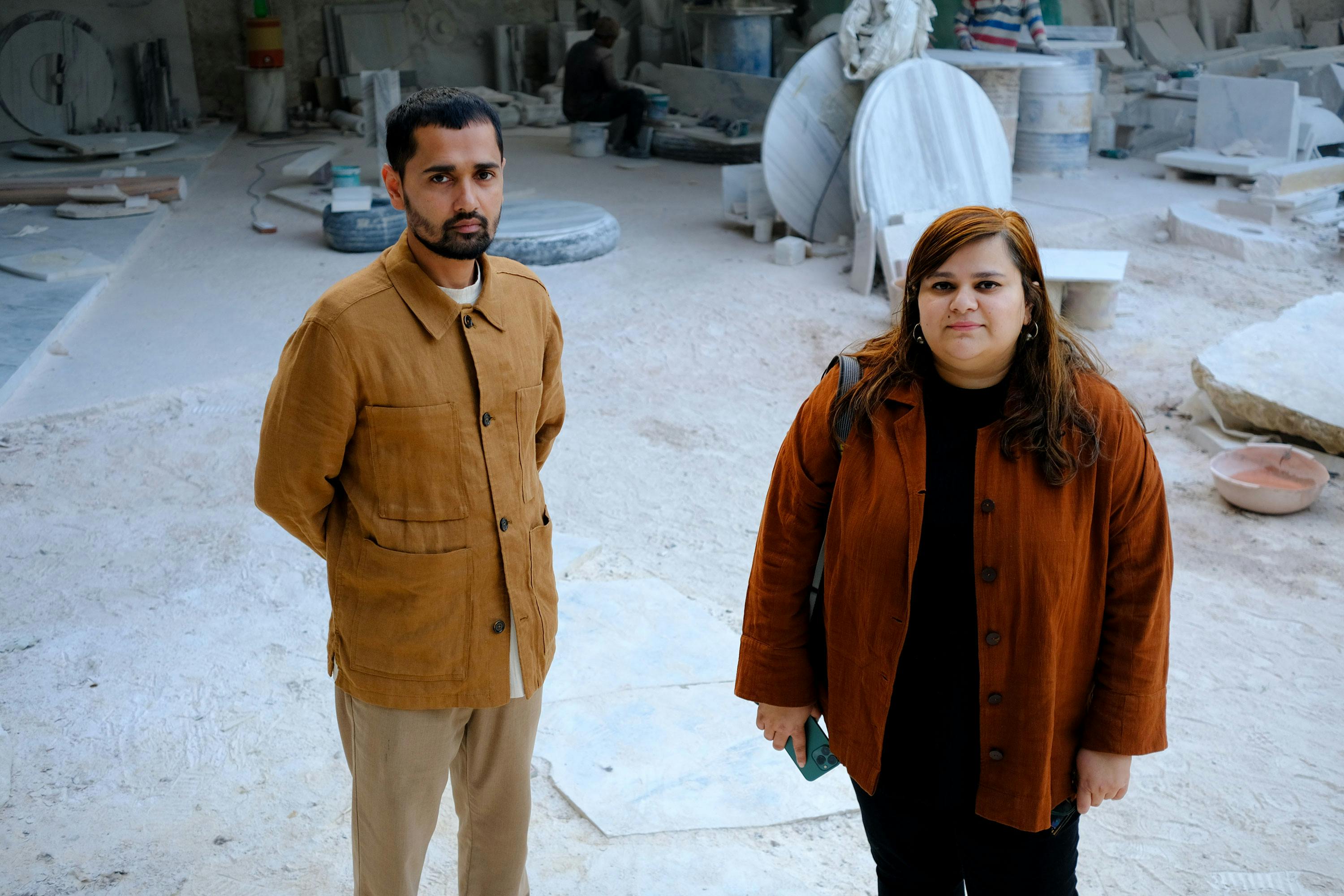
Studio Visit with Studio Raw Material
We do a studio visit in Rajasthan, India, with Rural Design Studio – Studio Raw Material
Studio Raw Material first reached out to me a while back, and at first glance, scrolling through images of refined marble objects on their feed—I thought, “Okay, beautifully executed, tasteful, but I get it.” Then they sent me their unpublished work, and I said, verbatim, “You’ve never shown this to anyone?” What I saw was two years of research and experimentation into the vernacular material and craft library of the Western Plains of India: hemp paper, insect resin, cactus sap, local stone, bamboo, wild clay.
I was, for once, speechless. It’s rare to meet designers who aren’t in a rush to be seen, who understand that some bodies of work need years of quiet development, and that there’s a certain clarity that only arrives when you’re not performing your process in public. As Cy Twombly was once quoted saying "Try and stay ignored for as long as possible.". It’s what allowed Studio Raw Material to develop a voice and a body of work that now stands among the most compelling in contemporary design, anywhere.
Based between Jaipur and Makrana, Priyanka Sharma and Dushyant Bansal describe their practice as a Rural Design Studio, one that engages not only with regional materials, but with local knowledge, vernacular architecture, and the inventive problem-solving that emerges in communities where resources are scarce and design is a matter of necessity.
We spoke about what it means to build a studio outside the gravitational pull of an urban centre—not just to avoid the transactional nature of city life, but to reinvest in their community, their people, their culture, and to do so within their own rhythm. We discussed climate, light, and landscape as collaborators in their process, and why this work, rooted in offcuts, trust, and time could only happen here, in India. Not anywhere else.

Kristen: How did you come to design and start to bridge design, architecture and material exploration?
क्रिस्टन: आप डिज़ाइन (अभिकल्पना) के क्षेत्र में कैसे आईं? और डिज़ाइन के साथ-साथ आर्किटेक्चर और कला के सामान की खोज के बीच तालमेल बनाने की शुरुआत कैसे हुई?
Priyanka_ We always wanted a studio practice where the outcome was not the main driving factor. We felt the need to move away from Delhi and unlearn our design education. We were fascinated by rural India, its crafts and everyday objects that have the most beautiful proportions, materials and textures one can find.
We wanted to learn more about India and had a feeling that we would discover something. It was like our little adventure, so we gave ourselves six months to try and find a purpose. We had some links to Makrana, and many of the designs you find there are really ornate but we were always drawn to the bare aesthetic from the humble houses made from foraged and discarded materials. That became our entry point into developing our specific aesthetic.
प्रियंका: हम हमेशा से स्टूडियो में काम का ऐसा माहौल चाहते थे जहां हमारा मकसद सिर्फ नतीजा पाना न हो। हम दिल्ली से दूर जाकर वह सब भूलना चाहते थे जो हमने डिज़ाइन की पढ़ाई के दौरान सीखा। हमें भारत के गांवों ने अपनी ओर खींचा, वहां की शिल्प कलाएं और यहां तक की उनकी रोजमर्रा के इस्तेमाल की चीजें जो बेहद खूबसूरत अनुपात में बनी हैं, उनकी सामग्री और बनावट देखने लायक है।
हम भारत को गहराई से समझना चाहते थे और ऐसा महसूस करते थे कि इस दौरान कुछ नया खोज सकते हैं। यह हमारे लिए बहुत रोमांचक था। हमने खुद को 6 महीने का वक्त दिया ताकि अपना मकसद तलाश सकें। मकराना में हमारे कुछ संपर्क थे, आप देखेंगे कि वहां का काम बहुत सजावटी होता है। लेकिन हम हमेशा उन साधारण घरों की खूबसूरती की ओर आकर्षित होते थे जो बचे-खुचे या कहीं से जुटाए गए सामान से बनते थे। वहीं से हमारा एक खास सौंदर्य का नज़रिया विकसित हुआ।
I got to visit you guys, and it was such a pleasure. Moving somewhere rural must help not get distracted by certain things or what other people are doing. Did that help you?
जब मैं आप लोगों से मिली तो मुझे बहुत खुशी हुई। ग्रामीण इलाके में जाने से आपको यह मदद मिली कि कुछ चीजें आपको भटका नहीं सकीं या ऐसे काम जो दूसरे लोग कर रहे हैं। क्या वाकई इससे आपको मदद मिली?
Dushyant_ Completely. We created a bubble and were very focused on our practice since there weren't other design practices around. And it's a nice thing to not have this sense of competitiveness but to pursue the excitement.
दुष्यंत: हां, बिलकुल। हमने अपने चारों ओर एक घेरा बना लिया था और सिर्फ अपने काम पर ध्यान लगाए रखा। वहां हमारे आसपास कोई दूसरा डिज़ाइन स्टूडियो नहीं था। यह अच्छी बात है कि तुलना करने का दबाव न हो लेकिन खूब उत्साह से काम करें।
How does sustainability come into consideration in your process or practice?
आपके काम या उसकी प्रक्रिया में टिकाऊपन (Sustainability) का कैसे ध्यान रखा जाता है?
Priyanka_ It was a practical choice for us. When you go to the source of an industry, you find there’s an excess of material. It was almost free here, so it made sense to use it. We like this idea that ‘sustainability should not be a choice, but a given when designing’, and the way we were working rang true to this philosophy. At the same time, it was the way indigenous design practices in this region were done, so it was all coming together and felt authentic.
प्रियंका: हमारे लिए यह सबसे व्यावहारिक फैसला था। जब आप किसी उद्योग के स्रोत पर जाएं तो पाएंगे कि वहां जरूरत से ज्यादा सामग्री पड़ी है। यहां वह सामान लगभग मुफ्त है। इसलिए उसे हमने अपने काम में इस्तेमाल करना शुरू किया। हमें यह विचार अच्छा लगा कि डिज़ाइन में टिकाऊपन कोई विकल्प नहीं होना चाहिए, बल्कि यह जरूरत होना चाहिए। हमारा सारा काम इस विचार के इर्दगिर्द है। इतना ही नहीं, इस क्षेत्र में जो डिजाइन बनाए जा रहे हैं वे भी इसी तरह के हैं। इस तरह हम साथ आए और वास्तविकता महसूस हुई।
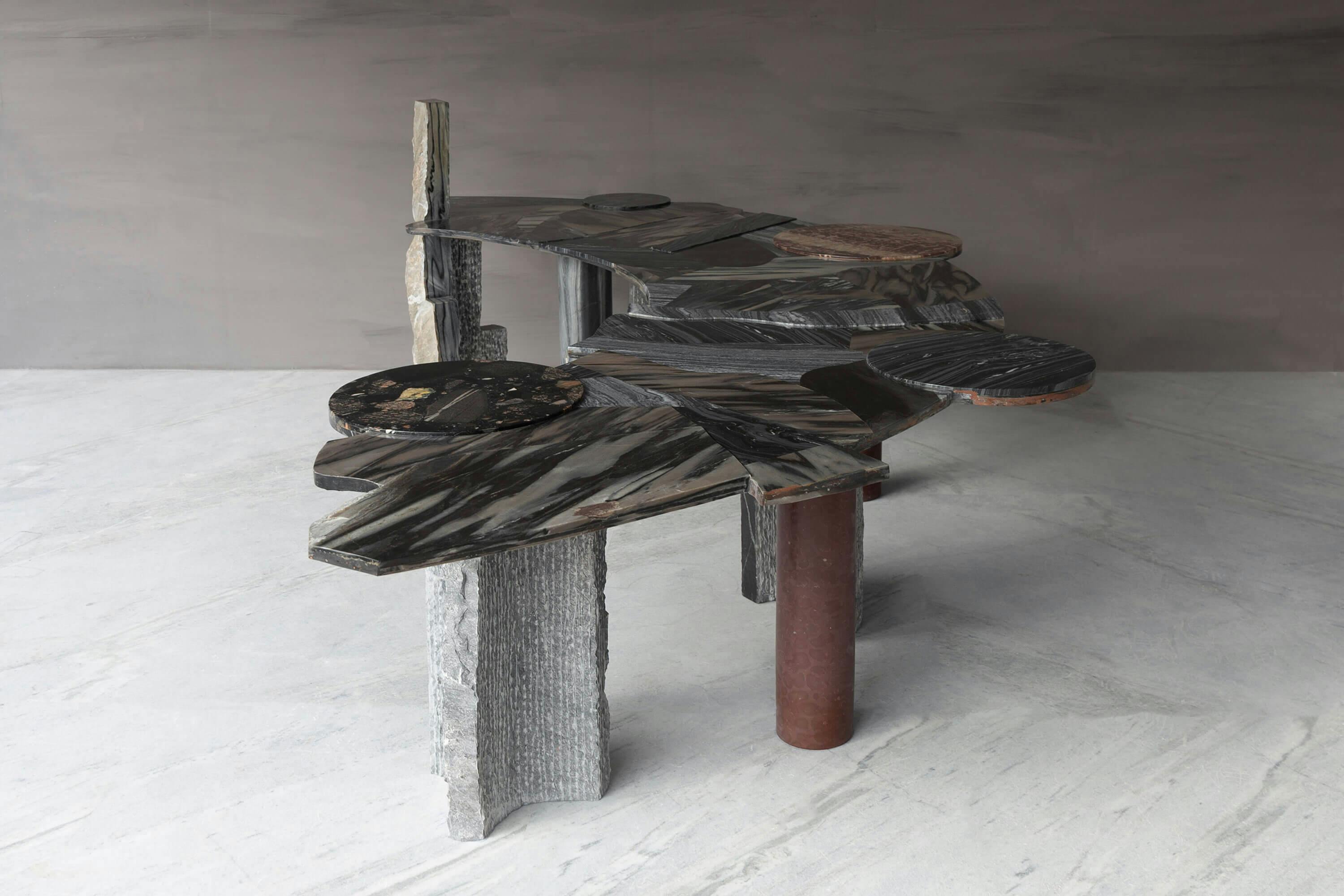

Weevolvefrompurelyurbantransactionalrelationshipstolong-standinginvestmentsinourpeople.
Dushyant Bashal on choosing to anchor themselves in India as a Rural Design Studio

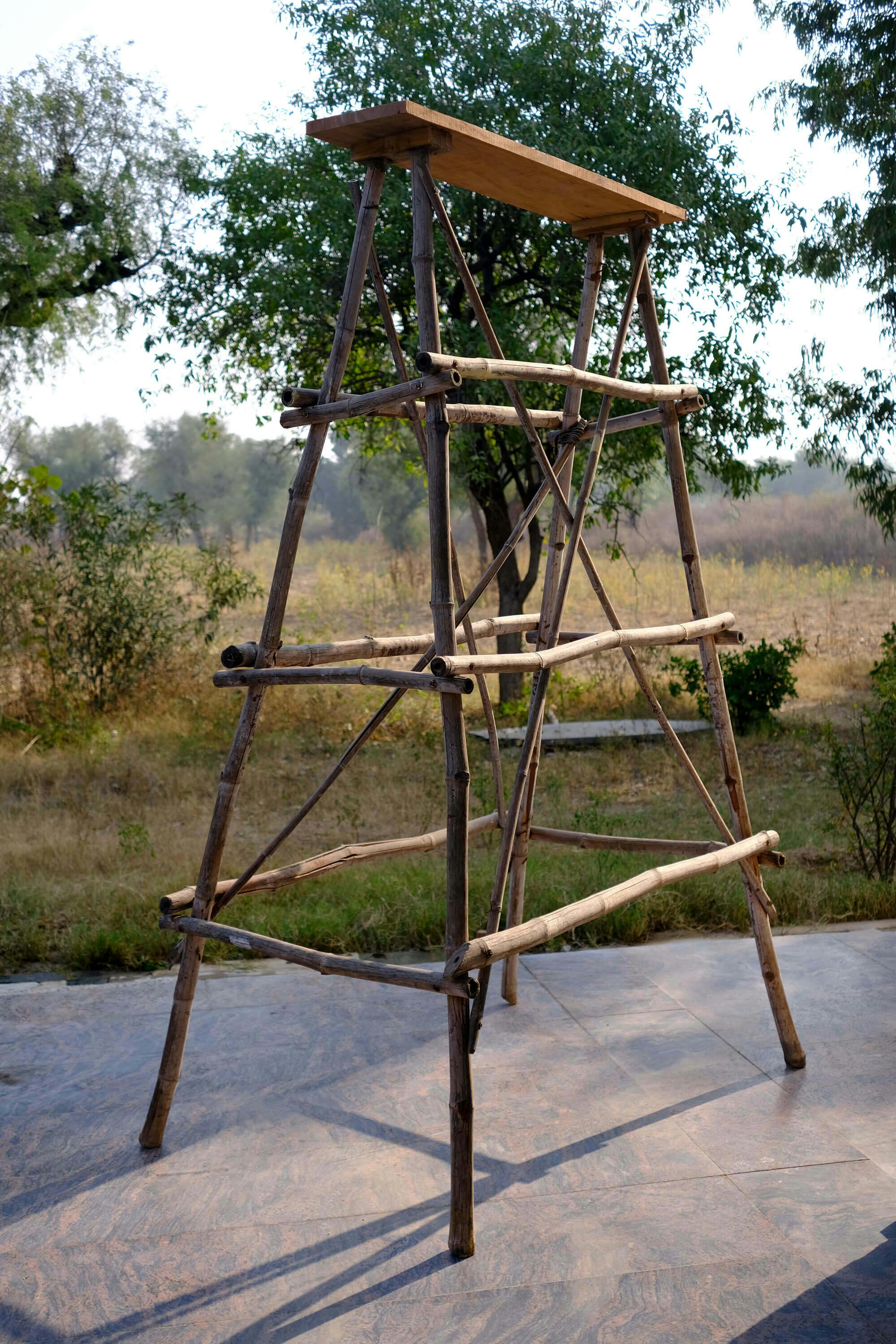
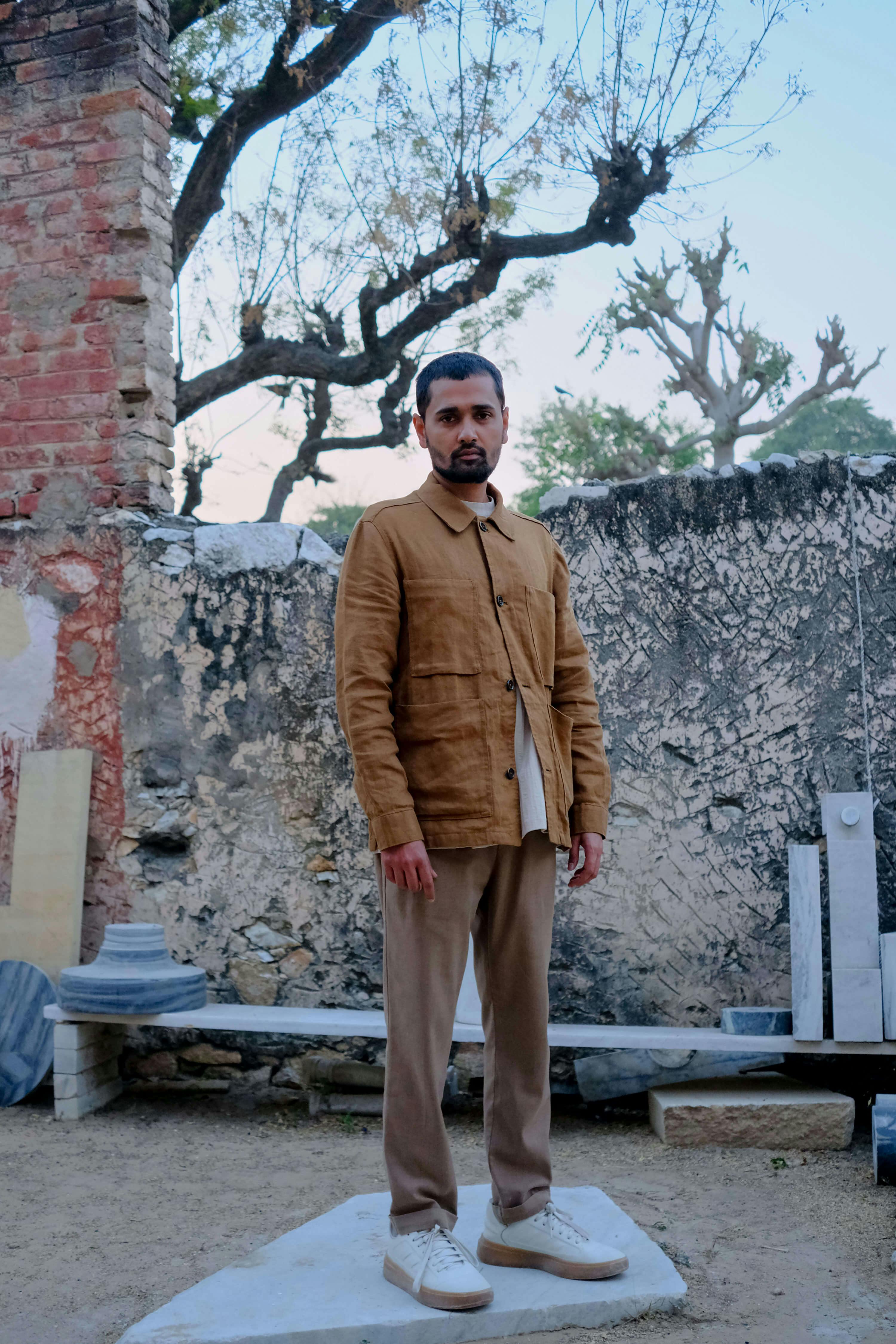
You define yourself as a rural design practice. What does that entail in your eyes?
आपने खुद को रूरल डिज़ाइन स्टूडियो के तौर परिभाषित किया है। आपके लिए इसका क्या मतलब है?
Dushyant: To start with, we set up in a rural area. It has always been a question in our minds: what does a rural design studio mean beyond its location? We can now see some of those aspects in retrospect, such as the strong focus on traditional knowledge and the interest in everyday inventiveness in the face of limited means. There is an emphasis on indigenous practices of using only local, usually free resources. 60% of the Indian population lives in rural areas and villages. Despite that, the focus of rural development is primarily on managing day-to-day activities. The severe lack of long-term vision in rural development policies creates a distinct rural-urban gap.
We evolve from the purely urban transactional relationships between employers and employees to create long-standing investments in our people. Also, the specificity of the region helps to create a stronger identity when you take into account weather conditions, ecology or quality of sunlight.
दुष्यंत: सबसे पहली बात तो यह कि हमने ग्रामीण क्षेत्र में स्टूडियो बनाया। लेकिन हमारे दिमाग में हमेशा से यह सवाल था कि ग्रामीण जगह से जुड़ाव के अलावा ग्रामीण डिज़ाइन स्टूडियो का क्या अर्थ हो सकता है? कुछ चीजें अब हम अच्छी तरह समझ सकते हैं, इसमें अपने पारंपरिक ज्ञान पर ध्यान केंद्रित करना, सीमित संसाधनों में क्रिएटिविटी की खोज करना आदि शामिल है। इस पर भी जोर दिया जाता है कि सिर्फ लोकल चीजों का इस्तेमाल करना, खासकर मुफ्त मिलनेवाले संसाधन। भारत की 60 फीसदी आबादी गांवों और ग्रामीण क्षेत्रों में रहती है। बावजूद इसके, ग्रामीण विकास मुख्य रूप से रोज़मर्रा के कामकाज को संभालने पर ध्यान देता है। ग्रामीण विकास नीतियों में लंबे समय की सोच कम दिखती है, इससे गांव और शहरों के बीच अंतर बढ़ता है।
शहरी कामकाजी रिश्ते जो इंप्लॉई और इंप्लॉयर के बीच होते हैं, हमने उससे आगे बढ़ते हुए अपने लोगों के साथ लंबे वक्त के लिए रिश्ते बनाए हैं। इसके अलावा, इस क्षेत्र की खासियत की वजह से मजबूत पहचान बनाने में मदद मिली, खासकर मौसम की स्थिति, पर्यावरण और धूप की गुणवत्ता की वजह से।
So it all started working with offcuts at the Marble Quarry. Since then, you've been exploring Rajasthan's material library and local crafts. What are some of the local materials around you in Jaipur and Makrana?
तो शुरुआत संगमरमर की खदान में बची हुई चीजों के इस्तेमाल से हुई। इसके बाद आपने राजस्थानी चीजों के भंडार और स्थानीय शिल्पकला की तलाश की। आपको जयपुर और मकराना के आसपास कौन-कौन सी स्थानीय सामग्री मिलीं?
Priyanka_ We have also been exploring limestone, sandstone and granite as well as indigenous plasters that include local sand, wild clay, cactus sap, lime, hay, crop husks and local resins that are insect and plant-based. We are currently using a lot of paper made with hemp fibres, a type that has been handmade since the 15th century. We’ve also been exploring some regional textiles and plant fibres and we grew our first crop of indigenous cotton last year.
प्रियंका: हमने चूना पत्थर, बलुआ पत्थर, ग्रेनाइट के साथ-साथ स्थानीय प्लास्टर का भी पता लगाया, जिनमें वहां की रेत, जंगली मिट्टी, कैक्टस का रस, चूना, घास, फसल का बचा हुआ भूसा और कीड़ों व पौधों से तैयार रेज़िन शामिल हैं। हम इस समय हैंप पौधे के रेशे से बने कागज़ का काफी इस्तेमाल कर रहे हैं, इस तरह का कागज़ 15वीं सदी से हाथ से बनाया जा रहा है। हम वहां के क्षेत्रीय कपड़ों और पौधों के रेशों पर भी काम कर रहे हैं और हमने इस साल अपनी पहली स्थानीय कपास की फसल भी उगाई है।
How do you start with a material like marble and have such a strong aesthetic visual language? How are you able to keep that when working with insect resin or paper?
आप जब संगमरमर जैसी चीज़ से शुरुआत करते हैं तो बेहतरीन सौंदर्यबोध कहां से पाते हैं? और फिर जब आप कीड़ों के रेज़िन या कागज़ के साथ काम करते हैं तो उस सौंदर्यबोध को कैसे बनाए रखते हैं?
Priyanka_ We approach most materials from two perspectives: understanding the traditional processes and learning through observation, the tools, and trying things out.
Dushyant_ We look at the processes and the visual language of what already exists with those materials, the crafts, and the motifs, understand their significance, and go deep into history. But some of the crafts are so prevalent that you have to disrupt and discard everything that's been done before. And in other cases, just a slight adjustment is required.
Priyanka_ There is no clear answer for how you get to the right aesthetics but I feel we have these methods about how we approach a new material and what works.
Dushyant_ We always talk about the sunlight, it’s such a strong factor because it's so abundant. It's something that you don't think of but it defines so much of how this landscape came to be in the first place, the sharp lines and the silhouettes all come from a very sharp sunlight and I think that's something that defines a lot of our work.
प्रियंका: हम ज्यादातर चीजों को दो तरह के नज़रिये से देखते हैं – पारंपरिक प्रक्रिया को समझना और देखकर सीखना, जैसे टूल्स का इस्तेमाल करना और चीजों को आजमाना।
दुष्यंत: हम उन प्रक्रियाओं और उस विजुअल भाषा को देखते हैं जो उन चीजों, शिल्प और नमूनों से जुड़ी है। इससे उनकी अहमियत समझते हैं और उनके इतिहास में गहराई तक जाते हैं। लेकिन कुछ शिल्प इतने आम होते हैं कि आपको पिछली सभी चीजों को बदलना और छोड़ना पड़ता है और कुछ मामलों में सिर्फ ज़रा-से बदलाव की जरूरत होती है।
प्रियंका: इसका कोई साफ जवाब नहीं हो सकता कि सही सौंदर्यबोध तक कैसे पहुंचा जाए, लेकिन मुझे लगता है कि हमारे पास यह तरीका है कि नई चीजों तक कैसे पहुंचें और क्या चीज काम करेगी।
दुष्यंत: हम हमेशा धूप की बात करते हैं, यह एक बड़ी वजह है क्योंकि यहां धूप बेशुमार है। यह ऐसी चीज है जिस पर आप ध्यान नहीं देते, लेकिन यह बहुत हद तक निश्चित करती है कि यह लैंडस्केप कैसे तैयार हुआ। तीखी रेखाएं और बाहरी रूपरेखा (Silhouette) तेज धूप से बनती हैं और मुझे लगता है कि यही बात बहुत हद तक हमारे काम को भी परिभाषित कर देती है।
That's so interesting. It’s true you can get so depressed in Paris because of the lack of sunlight.
काफी दिलचस्प बात है। यह सच है कि आप पैरिस में उदास हो सकते हैं क्योंकि वहां धूप की कमी है।
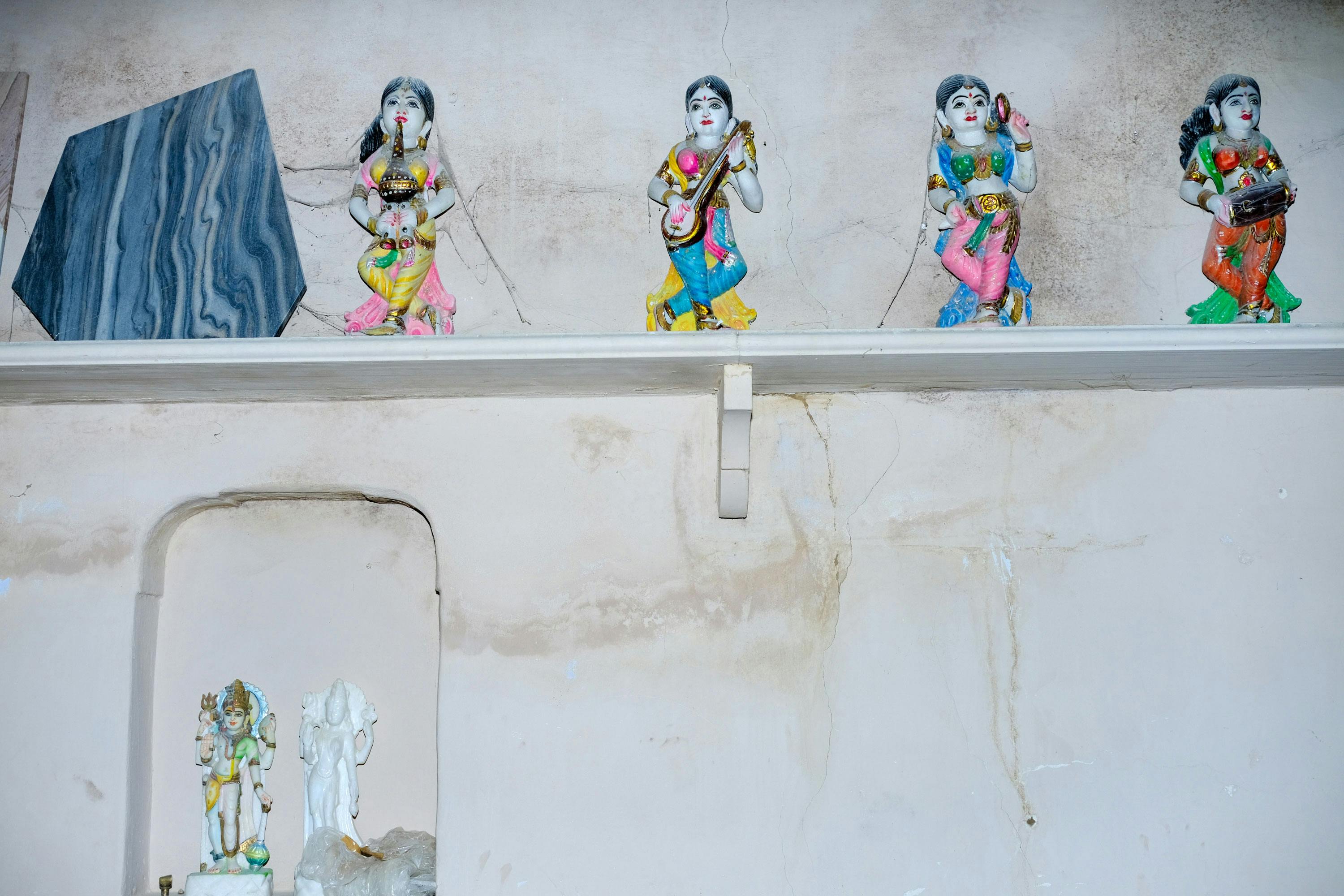
Can you tell me about the local crafts and how you apply them or innovate?
क्या आप स्थानीय शिल्पकला के बारे में बता सकती हैं और आपने उन्हें कैसे अपनाया?
Priyanka_ Jaipur was set up in the early 18th century with a very strong emphasis on craft communities leveraging the importance of Rajasthan on the silk route. Adapting these crafts is a very slow process. On one end we look at traditional knowledge, observing the tools, gestures, visual language, motifs and their meanings. On the other end, you explore it from a completely experimental point where you discard all the history it comes with to slowly find the right point, where you may have completely altered or made slight adjustments to the traditional process. We have been working on the paper project for the last 2 years and haven’t formally shared our work yet.
प्रियंका: जयपुर की स्थापना 18वीं सदी की शुरुआत में हुई थी और इसमें शिल्पकारों के समुदायों पर बहुत जोर दिया गया था ताकि सिल्क रूट पर राजस्थान की अहमियत का फायदा उठाया जा सके। इन पारंपरिक शिल्पों को अपनाने की प्रक्रिया बहुत धीमी होती है। एक ओर हम उनका पारंपरिक ज्ञान देखते हैं- उनके औजार, काम करने का तरीका, विजुअल भाषा, नमूने और उनके मायने। दूसरी तरफ हम पूरी तरह प्रयोग के नज़रिये से देखते हैं जहां इतिहास को अलग रखकर नए तरीके से खोज करते हैं। धीरे-धीरे हम उस सही पॉइंट तक पहुंचते हैं, जहां या तो परंपरा को पूरी तरह बदल दिया जाता है या उसमें हल्के-फुल्के बदलाव किए जाते हैं। हम पिछले दो बरसों से पेपर प्रोजेक्ट पर काम कर रहे हैं, हालांकि हमने अब तक औपचारिक रूप से अपना काम नहीं दिखाया है।
When I was visiting you, you had all different types of craftsmen, but I was taken by Hamid Ji and the bamboo craft. How did you first approach him to work with you?
जब मैं आपसे मिलने आई थी तो आपके पास अलग-अलग तरह के कारीगर थे, पर मैं खासतौर पर हामिद जी और उनकी बांस की कला से बहुत प्रभावित हुई थी। आपने पहली बार उन्हें अपने साथ काम करने के लिए कैसे तैयार किया?
Dushyant_ It was a very slow build of trust.
Priyanka_ It was a bit slow with him, especially, because this craft is practised more for his religion and they would make these beautiful Tazia structures for processions.
Dushyant_ Most of the craftspeople in this region are daily wage workers. So they need more time or space to experiment with their craft or try new techniques. We offer them full-time employment because we also know that a lot of time will be wasted just trying things out. It also offers them this security.
Priyanka_ So we have to find people who are open to this kind of experimentation.
दुष्यंत: भरोसा बनने की यह प्रक्रिया बहुत धीमी थी।
प्रियंका: खासतौर पर हामिद जी के साथ यह प्रक्रिया वाकई थोड़ी धीमी रही क्योंकि यह शिल्पकला उनके धर्म से गहराई से जुड़ी है। वह धार्मिक जुलूसों के लिए ताज़िया जैसी खूबसूरत चीजें बनाते हैं।
दुष्यंत: इस क्षेत्र में अधिकतर कारीगर दिहाड़ी मजदूर होते हैं। इसलिए उनके पास अपनी शिल्पकला में प्रयोग करने या नई तकनीकें आजमाने के लिए वक्त या मौका कम ही होता है। हम उन्हें फुल टाइम का रोजगार देते हैं क्योंकि हमें पता है कि नई चीजों को आजमाने में काफी वक्त लगेगा। इससे उन्हें एक तरह की सुरक्षा भी मिलती है।
प्रियंका: इसलिए हमें ऐसे लोगों की तलाश करनी पड़ती है जो इस तरह के प्रयोगों के लिए खुला दिमाग रखें।
What's the kind of reaction with the final pieces if they're used to doing one specific thing?
जब वे एक ही तरह की चीजें करने के आदी होते हैं तो आपके यहां फाइनल तैयार चीजों के बारे में उनकी प्रतिक्रिया कैसी होती है?
Priyanka_ The Makrana team and people who work with stone and marble get it because it's been almost five years.
Dushyant_ You also have to get their attention by doing something odd.
प्रियंका: मकराना की टीम और जो लोग पत्थर और संगमरमर पर काम करते हैं, वे इसे समझते हैं क्योंकि करीब 5 साल हो गए हैं।
दुष्यंत: उनका ध्यान खींचने के लिए कुछ अलग करना पड़ता है।
You want to earn their approval which must be quite rewarding in the end.
आखिर में आपके लिए उनकी सहमति पा लेना काफी संतोषजनक होता होगा।
Priyanka_ We have long lead times because if someone’s not going to be there for a while, we just respect it.
Dushyant_ Other times, we’ve successfully asked them to work with us on short lead times, so they also value our deadlines.
प्रियंका: हमारे पास काफी वक्त होता है क्योंकि अगर कोई थोड़े वक्त के लिए नहीं आ रहा तो हम इस बात का सम्मान करते हैं।
दुष्यंत: कई मौकों पर हम कम वक्त देकर भी उन्हें अपने साथ काम करने को राजी कर चुके हैं। जिससे वे भी हमारी समयसीमा को अहमियत देते हैं।
It's a very human way of working and you can rely on them that they're going to be there even way beyond what they're expecting.
यह काम करने का काफी मानवीय तरीका है और आप भरोसा कर सकते हैं कि वे साथ होंगे, भले ही वे इसकी उम्मीद न कर रहे हों।
Dushyant_ Community is such an ingrained part of how everything works in India. It’s also a part of the rural design studio practice, immersing yourself in these different rhythms and accepting the eccentricities, like taking a 15-day leave without telling you why.
दुष्यंत: समुदाय यह बताते हैं कि कैसे भारत में सारे काम होते हैं। यही रूरल डिज़ाइन स्टूडियो के काम का तरीका भी है। जहां आप अलग-अलग लोगों को अपनाते हैं और उनकी खासियतें स्वीकार करते हैं जैसे- बिना वजह बताए 15 दिन की छुट्टी लेना।
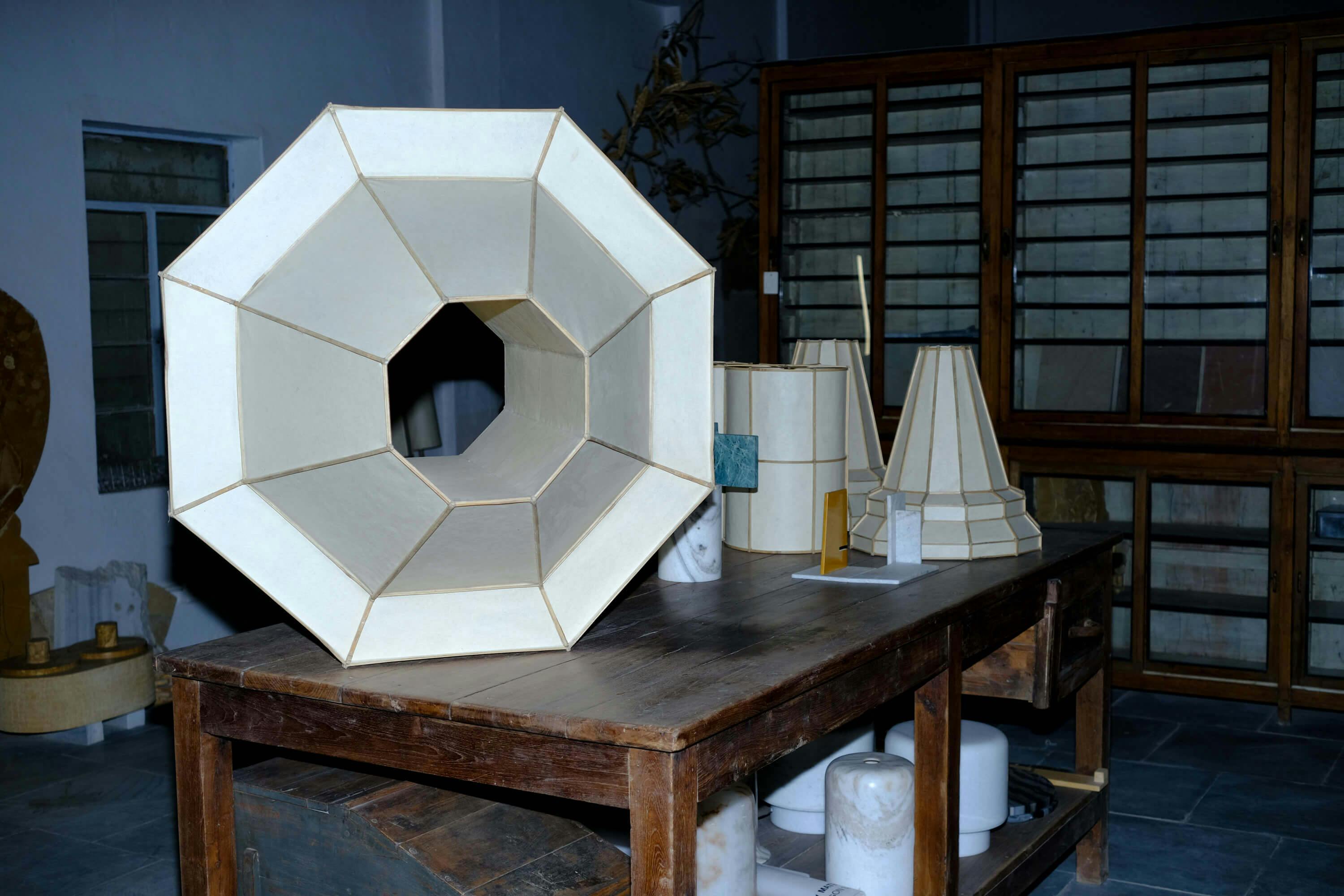
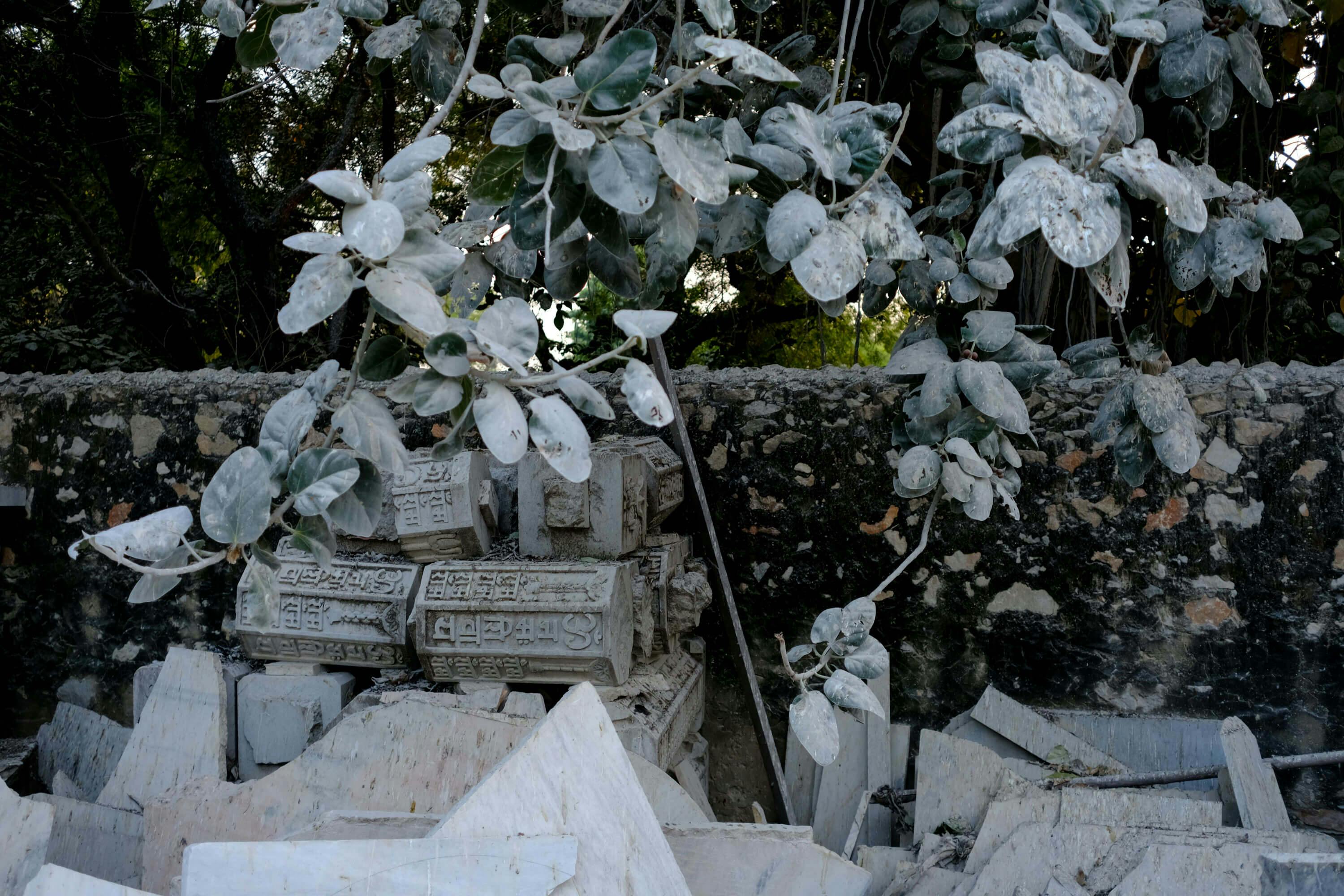
What is your stance on saving traditional craft?
पारंपरिक शिल्प के संरक्षण के लिए आप क्या सोचती हैं?
Priyanka_ Craft is a very loaded term in India. Academics and scholars may understand it well, while sometimes a craftsperson might not. For us, having better living standards and dignity for the people is more important than saving all traditional crafts. Craftspeople are often seen as semi-skilled labourers, and many abandon their practices because they cannot earn enough.
प्रियंका: भारत में शिल्प बहुत गहरे अर्थवाला शब्द है। विद्वान और अकादमिक लोग इसे अच्छी तरह समझ सकते हैं, लेकिन कभी-कभी कारीगर समझ नहीं पाता। हमारे लिए पारंपरिक शिल्प कलाओं को बचाने से ज्यादा जरूरी है, उन लोगों के जीवन स्तर और उनकी गरिमा को बेहतर बनाना। कारीगरों को अक्सर कम कुशल मजदूर समझा जाता है और कई लोग अपनी शिल्पकारी छोड़ देते हैं क्योंकि वे इससे अच्छी कमाई नहीं कर पाते।
I was intrigued by the vernacular architecture: Tea stands made of huge marble slabs, and bus stop benches. What is the average person's relation to buildings and materials in the area?
मैं यहां के आर्किटेक्चर से बहुत प्रभावित हुई- जैसे संगमरमर की बड़ी स्लैब से बनी चाय की दुकानें और बस स्टॉप की बेंच। इस इलाके में आम आदमी का इमारतों और इन सामानों से क्या संबंध है?
Priyanka_ It is an integral part of an average person’s life. One important aspect of our practice is to observe and learn from what we see around us. There are a lot of discarded marble blocks used as furniture and building material in everyday life. So this idea of reusing is very present. A fundamental principle of the approach is to make do with very little and work within the economy of means. These are rural communities where sustainability is evident.
With time, most of our team has come to understand the distinctiveness of this aesthetic.
प्रियंका: ये चीजें किसी आम आदमी की ज़िंदगी का अभिन्न हिस्सा हैं। हमारे काम का अहम पहलू यह है कि हम अपने आसपास जो देखते हैं, उससे सीखते और उसे अपनाते हैं। यहां रोज़मर्रा के जीवन में फर्नीचर और इमारत के सामान के तौर पर बहुत-से बचे हुए या फेंके हुए संगमरमर के टुकड़ों का इस्तेमाल होता है। इसलिए चीजों को फिर इस्तेमाल करने का विचार यहां पहले से मौजूद है। हमारे काम के तरीके का एक मूल सिद्धांत है कि बहुत कम साधनों के साथ और सीमित संसाधनों में अपना काम करें। इन ग्रामीण समुदायों के जीवन में टिकाऊपन साफ दिखता है। वक्त के साथ, हमारी टीम भी इस सौंदर्य की अहमियत समझने लगी है।
How has the local vernacular architecture inspired you?
यहां की वास्तुकला ने आपको क्या प्रेरणा दी?
Dushyant_ It’s at the core of our practice. Vernacular design articulates local culture, economy, and environmental awareness which contributes to a strong visual identity.
दुष्यंत: यह हमारे काम के मूल में है। यहां की वास्तुकला, स्थानीय डिजाइन, स्थानीय संस्कृति, अर्थव्यवस्था, और पर्यावरण की जागरूकता को दिखाती है, जो मजबूत विजुअल पहचान है।

You recently did a residency in Al-'Ula where you explored local materials. How did that build on your existing body of work?
आपने हाल ही में सऊदी अरब के अल-'उला (Al-'Ula) में कुछ वक्त बिताया था और वहां की स्थानीय सामग्री की तलाश की थी। इससे आपके काम में क्या बदलाव आया?
Dushyant_ Finding a connection between the two desert regions of Rajasthan and Saudi we found routes linking Saudi Arabia to India for resin-based incense trade.
We approached it by going back to how we started our practice, using the abundantly available resources around us. Sunlight was a big entry point for this project, as well as broken rocks, various mineral and plant matter. This pushed us to think about how making can exist in a place without industry and production capability. The first objects we made were a set of basic iron tools based on the historical record of what was used in Al-’Ula (Dadan & Hegra).
We felt that the spectacular already existed there on a grand scale in the landscape, so we wanted to create a balance by making humbler objects which invite the viewer to look deeper into the experience of existing in that materiality.
दुष्यंत: राजस्थान और सऊदी अरब के दो रेगिस्तानी इलाकों के बीच का रिश्ता खोजते हुए हमें भारत-सऊदी अरब के बीच रेज़िन से जुड़े व्यापार का पता चला। हमने वापस लौटकर इसे उसी तरह अपनाया जैसा हमने अपनी प्रैक्टिस की शुरुआत में किया था यानी अपने आसपास मौजूद संसाधनों का इस्तेमाल करके। इस प्रोजेक्ट के लिए धूप बहुत बड़ा सहारा थी, साथ ही पत्थर के टुकड़े, अलग-अलग खनिज और पौधों की सामग्री। इसने हमें यह सोचने पर मजबूर किया कि कोई चीज बिना उद्योग और उत्पादन क्षमता वाली जगह पर कैसे तैयार हो सकती है। हमने सबसे पहले जो चीजें बनाईं, वे लोहे के कुछ साधारण औजार थे जो अल-'उला (ददान और हेग्रा) में इस्तेमाल किए गए ऐतिहासिक रिकॉर्ड पर आधारित थे। हमने महसूस किया कि वहां कुदरती परिवेश में पहले ही बड़े पैमाने पर भव्यता थी, इसलिए हमने ऐसा संतुलन बनाने की कोशिश की जिसमें सरल चीजें बनाई जाए, जो दर्शकों को उस सामग्री की भौतिकता के अनुभव में उतरने को आकर्षित करें।
Can you tell us a little bit about the collection made during that residency?
क्या आप उस प्रवास के दौरान तैयार किए गए संग्रह के बारे में बता सकती हैं?
Priyanka_ It’s a lot about memory and the physical sensations of being there. The studies we made are like tools to reflect on and sediment our time there, in the form of marks on found rocks, a cornice structure from Hegra trying to capture the slanted winter solstice light or a found dry branch covered with sand. We repurposed a local Bedouin tent to exhibit these studies accompanied by looped sounds of mark-making interrupted by reverberations and moving images. The tent acts as a temporary shelter where one may exist within its hazy borders.
प्रियंका: यह संग्रह यादों और वहां की भौतिक अनुभूतियों के बारे में है। हमने जो अध्ययन किए वे ऐसे औजारों की तरह हैं जो हमारी वहां बिताए गए वक्त को समझने में मदद करते हैं- जैसे मिले हुए पत्थरों पर बनाए गए निशान, हेग्रा की एक कॉर्निस संरचना जो ढलती हुई सर्दियों की संक्रांति की तिरछी रोशनी को पकड़ने की कोशिश करती है या रेत से ढकी एक सूखी शाखा। हमने इन अध्ययनों को प्रदर्शित करने के लिए एक स्थानीय बेदुईन तंबू का नया रूप देकर इस्तेमाल किया। इस प्रदर्शनी के साथ-साथ सतहों पर निशान बनाने की आवाजें, उनकी गूंज और चलती हुई छवियां लगातार दोहराई जाती रहीं। यह तंबू अस्थायी आश्रय का काम करता है, जहां कोई शख्स उसकी धुंधली सीमाओं के भीतर खुद को अनुभव कर सकता है।
You're a big fan of writer Arundhati Roy. What about her work and point of view is inspiring to you?
आप लेखिका अरुंधति रॉय के प्रशंसक हैं। उनके काम और नज़रिये से आपको क्या प्रेरणा मिलती है?
Dushyant_ This answer could be a whole separate interview. We try to live up to this wonderful quote, almost a manifesto for life: "To love. To be loved. To never forget your own insignificance. To never get used to the unspeakable violence and the vulgar disparity of life around you. To seek joy in the saddest places. To pursue beauty in its lair. To never simplify what is complicated or complicate what is simple. To respect strength, never power. Above all, to watch. To try and understand. To never look away. And to never, never forget.
दुष्यंत: इस सवाल का जवाब देने के लिए अलग-से पूरा इंटरव्यू हो सकता है। हम उनकी इस अनूठी बात को जीने की कोशिश करते हैं, जो ज़िंदगी के लिए घोषणापत्र जैसा है: "प्यार करना। प्यार किया जाना। कभी अपनी अहमियत को न भूलना। अपने आसपास की अनकही हिंसा और ज़िंदगी की भद्दी असमानता को कभी स्वीकार न करना। सबसे दुखद जगहों में खुशी ढूंढ़ना। सौंदर्य को उसके एकांत में तलाशना। कभी भी जटिल चीज़ों को सरल न बनाना या सरल चीज़ों को जटिल न बनाना। ताकत का सम्मान करना, सत्ता का नहीं। इन सबसे बढ़कर, देखना। समझने की कोशिश करना। कभी मुंह नहीं मोड़ना। और कभी भी भूलना नहीं।"


Speaking of Makrana, we visited the house you built in Makrana near your workshop. Tell us about the house's concept and what you explored with it.
मकराना की बात करते हैं, हमने मकराना में आपकी वर्कशॉप के पास बनाया गया घर देखा है। उस घर के कॉन्सेप्ट के बारे में कुछ बताएं और इससे आपने क्या खोज की?
Priyanka_ This house started at the same time as our practice. It was nice to see how we could study, interpret, and explore what we wanted to do on very different scales.
Dushyant_ The other idea was that there is this strong concept in certain cultures like Japan about the master craftsman, and that also exists in India where people want to get the best craftsman or the best team to do a certain thing. We were very anti that. We've spoken about this incredible, inventive and very thrifty response to what exists around you. So, that's something we got to explore with this house. We used the local waste material and local craftspeople who aren't builders at all, but people who work with stone and build their own houses to see what we can create with these very humble resources.
Priyanka_ And you could see how over time people got better over time.
Dushyant_ Or if different teams made something.
We also looked at a lot of local structures that exist, and the way people make their local houses. They're really simple, humble, rectangular forms. We took that type of form that emerges from the landscape by itself.
Priyanka_ And play with the scale and proportions, adjacent to something that exists.
प्रियंका: यह घर हमारी प्रैक्टिस के साथ-साथ ही बनना शुरू हुआ। यह देखना अच्छा लगा कि कैसे हम अलग-अलग पैमानों पर अपनी पढ़ाई, व्याख्या और खोज का इस्तेमाल कर सकते हैं।
दुष्यंत: एक विचार यह भी था कि कुछ संस्कृतियों जैसे जापान में 'मास्टर कारीगर' का कॉन्सेप्ट बहुत मजबूत है। भारत में भी लोग किसी खास काम के लिए सबसे अच्छे कारीगर या टीम को लेना चाहते हैं। लेकिन हम इसके खिलाफ थे। हमने इस बात पर ध्यान दिया कि अपने आसपास जो चीजें हैं, उन्हीं का नई तरह से और किफायती तरीके से इस्तेमाल कैसे किया जा सकता है। यही हमने इस घर में खोजा। हमने आसपास से बचा हुआ सामान लिया और ऐसे स्थानीय कारीगरों को काम में लगाया जो बिल्डर नहीं हैं, बल्कि पत्थरों के साथ काम करते हैं और अपने घर बनाते हैं। हम देखना चाहते थे कि इन सीमित साधनों से हम क्या बना सकते हैं।
प्रियंका: वक्त के साथ देखा गया कि लोग किस तरह इस काम में बेहतर होते गए हैं।
दुष्यंत: या जब अलग-अलग टीमों ने कुछ बनाया। हमने आसपास कई इमारतें भी देखीं और जिस तरह से लोग अपने साधारण, आसान से आयताकार घर बनाते हैं। हमने उसी स्वरूप को अपनाया जो अपने आप लैंडस्केप से उभरता है।
प्रियंका: उसी आकार और अनुपात के साथ तालमेल बिठाया ताकि इसे मौजूदा चीज़ों के साथ जोड़ा जा सके।
It's like you've remastered the local language or context.
यह ऐसा था जैसे आपने स्थानीय भाषा या संदर्भ को फिर से नया रूप दिया हो।
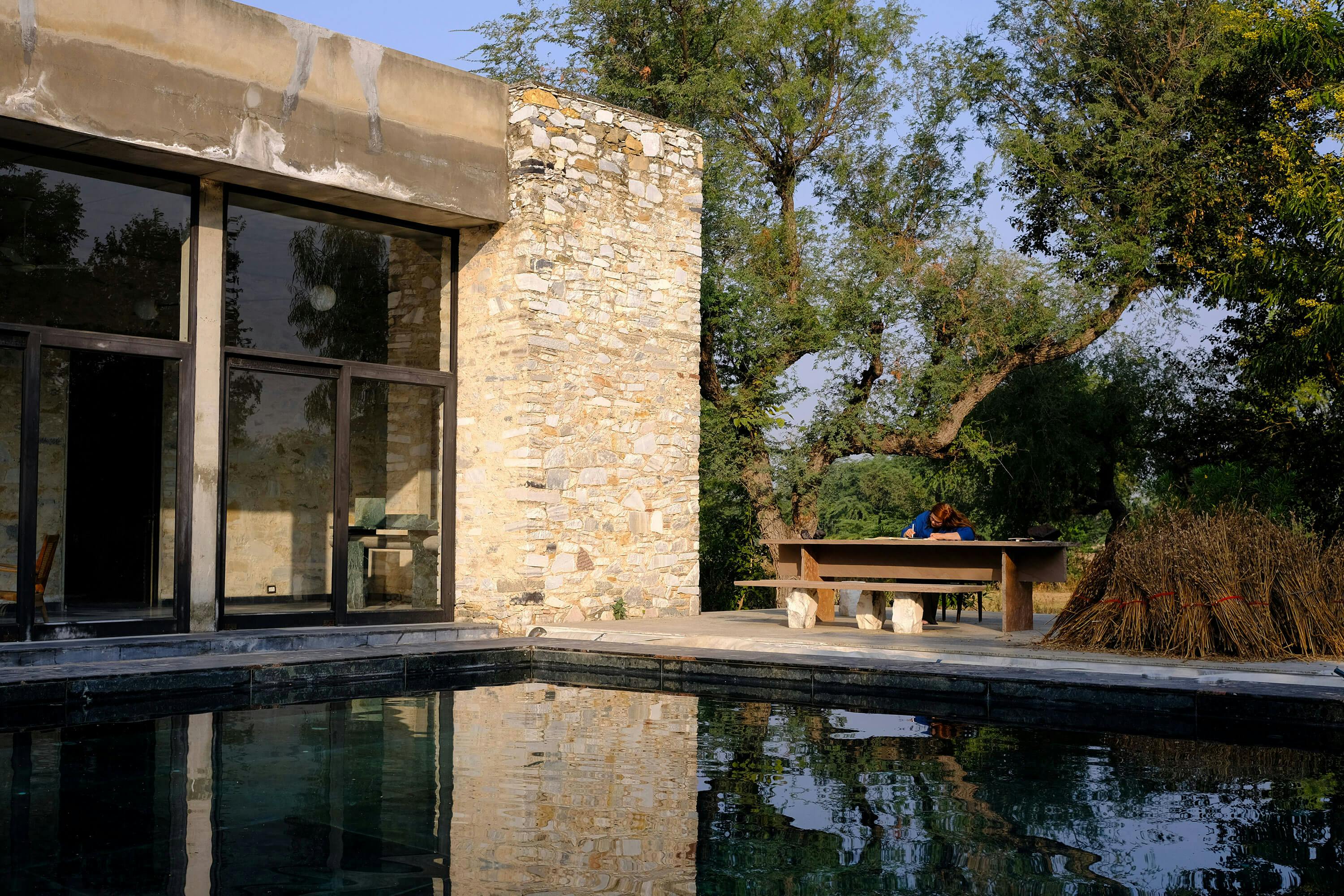
You both studied at RCA in London. Was it ever a difficult decision to decide where to establish your studio? Looking back, what are your reflections on your career and how was choosing to establish yourself in Jaipur integral to that?
आप दोनों ने लंदन में RCA (रॉयल कॉलेज ऑफ आर्ट) में पढ़ाई की है। क्या यह मुश्किल फैसला था कि अपना स्टूडियो कहां बनाएं? पीछे मुड़कर देखें तो अपने करियर के बारे में क्या सोचते हैं और जयपुर में खुद को स्थापित करने फैसला आपके लिए कितना अहम था?
Dushyant_ Being in RCA solidified the decision to be here because I think what RCA does well is to encourage you to have your practice.
Priyanka_ We had done a lot of the work before RCA.
Dushyant_ The response we got in India made us a bit unsure, but completing our degrees solidified that decision. Because it also talks a lot about the social aspect and social responsibility of a designer.
Priyanka_ It was like a little incubation time for us because we had a lot of these ideas, but we didn't trust ourselves enough at that point. Even though we were working with different materials, the emphasis was on, what is your practice? Who are you as a person?
Dushyant_ And what are your principles? What is the base? The fundamental approaches that you value and working towards externalising that value system through your work.
दुष्यंत: RCA में होने की वजह से ही यह फैसला लेना आसान हुआ क्योंकि मुझे लगता है कि RCA आपको प्रोत्साहित करना है कि अपनी प्रैक्टिस करें।
प्रियंका: हमने RCA में जाने से पहले ही काफी काम कर लिया था।
दुष्यंत: भारत में हमें जो रेस्पॉन्स मिला, उससे थोड़ी अनिश्चय की स्थिति बनी थी। लेकिन अपनी डिग्री पूरी करने के बाद फैसला पक्का हो गया क्योंकि यह किसी डिज़ाइनर की सामाजिक जिम्मेदारी और उसके सामाजिक पहलुओं की भी बात है।
प्रियंका: यह हमारे लिए शुरुआती तैयारी का वक्त था क्योंकि हमारे पास कई आइडियाज़ थे। लेकिन उस वक्त हम अपने आप पर पूरी तरह भरोसा नहीं कर सकते थे। भले ही हम अलग-अलग मटीरियल या सामान को लेकर काम कर रहे थे, लेकिन जोर इसी बात पर था कि आपकी प्रैक्टिस किस बारे में है? आप एक शख्स के तौर पर कैसे हैं?
दुष्यंत: ...और आपके सिद्धांत क्या हैं? उसका आधार क्या है? आपका मूल नज़रिया क्या है जिनकी आप कद्र करते हैं और अपने काम के जरिये उस वैल्यू सिस्टम को बाहरी रूप देने की दिशा में काम करते हैं।
Externalise your value system. Very interesting and important.
अपने वैल्यू सिस्टम को बाहरी रूप देना। यह बहुत दिलचस्प और अहम है।
Priyanka_ Their thought is critical, but at the same time freeing; they just want you to be true to yourself in a way. And we felt encouraged to have our practice. It was a really good education and a great contrast with an education in an Indian design school.
प्रियंका: यह सोच आलोचनात्मक है, लेकिन साथ ही आपको मुक्त भी करती है। वे सिर्फ इतना चाहते हैं कि आप उनके प्रति सच्चे रहें और हमने महसूस किया कि इससे हमें अपनी प्रैक्टिस शुरू करने का हौसला मिला। असल में यह बहुत अच्छी सीख थी और भारतीय डिज़ाइन स्कूल की पढ़ाई से बिलकुल अलग।
It seems it unlocks new ways of viewing the potential of your work.
ऐसा लगता है कि इसने संभावित काम करने के लिए नया नज़रिया दे दिया।
Dushyant_ Also our perspective on our careers. We both took away different things. As for Priyanka, it was about having your personal practice and being true to yourself.
And for me, it was about the value system. So it's quite interesting that the two of us came together and those two approaches also inform one another.
दुष्यंत: इसने हमारे करियर को देखने का नज़रिया भी बदला है। हम दोनों ने वहां से अलग-अलग चीजें सीखीं। प्रियंका के लिए यह अपनी पर्सनल प्रैक्टिस करने और खुद के प्रति सच्चे बने रहने की बात थी। वहीं मेरे लिए यह वैल्यू सिस्टम की अहमियत की बात थी। तो यह काफी दिलचस्प है कि हम दोनों एक साथ आए और हमारे दोनों नज़रिये भी एक-दूसरे को प्रभावित करते हैं।
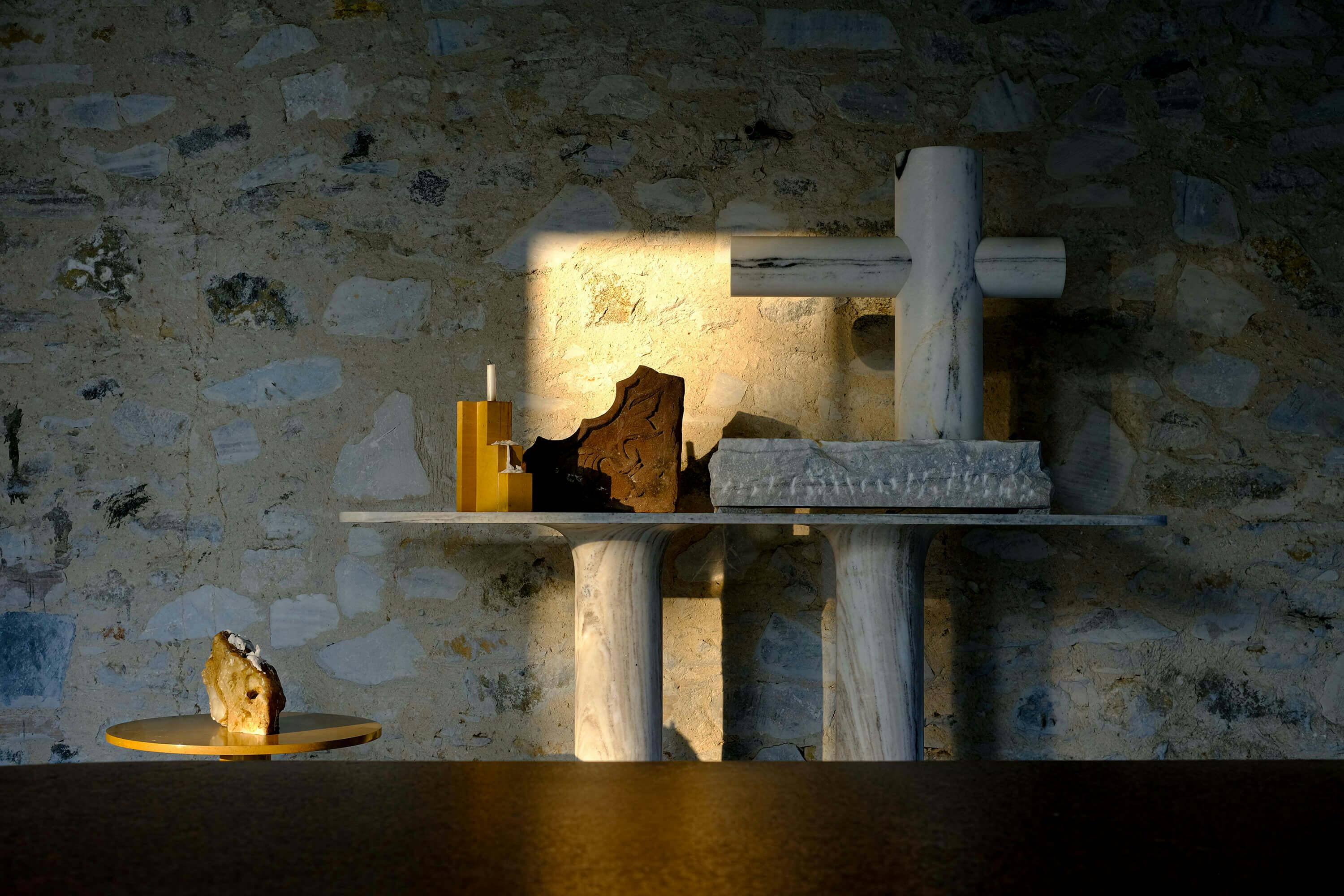
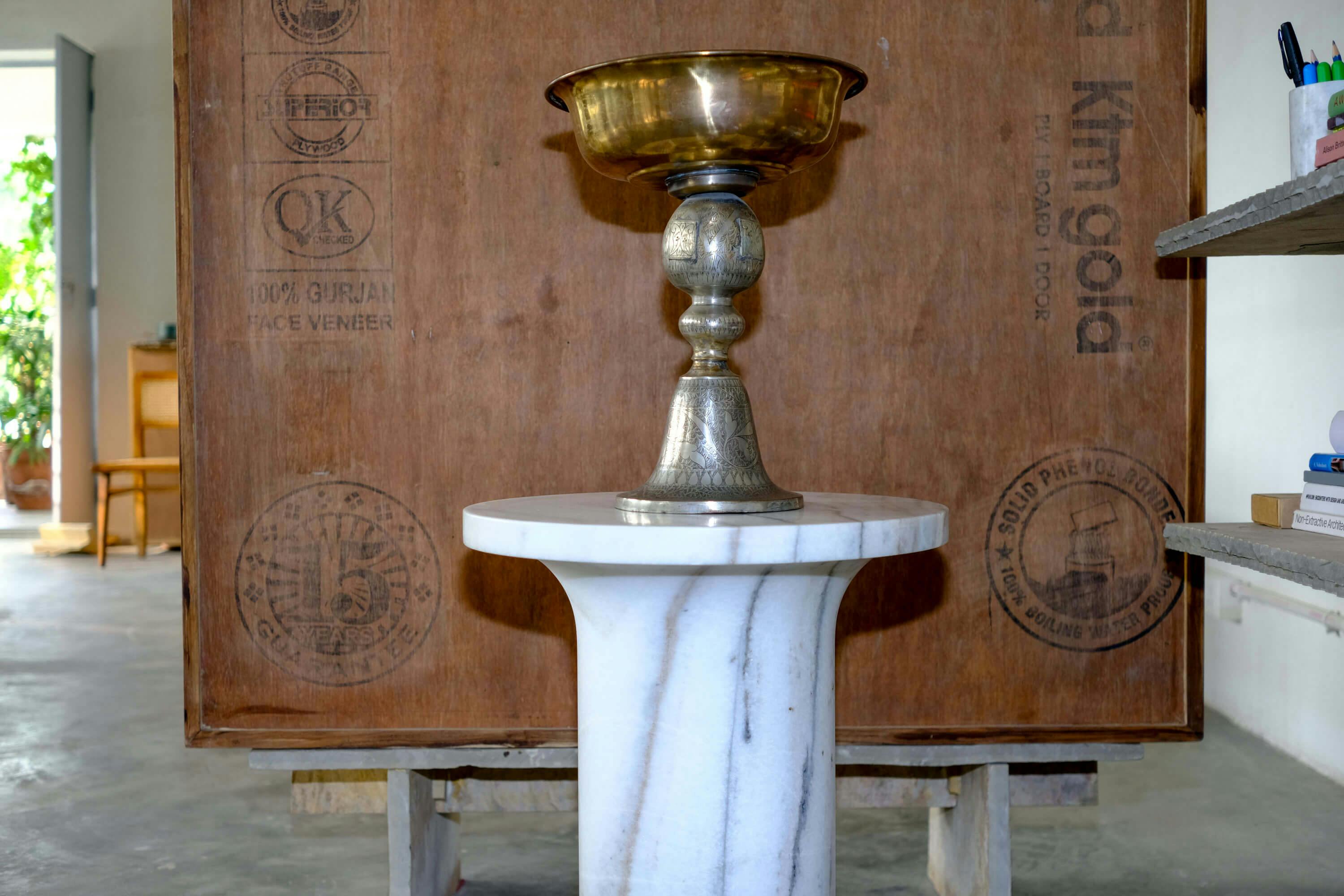
What would your practice look like if you were two separate practices?
अगर आप दोनों का काम अलग तरह का होता यानी आपकी अलग-अलग प्रैक्टिस होती तो कैसा लगता?
Priyanka_ We were lucky that we got along so well as friends and with what our value system was or the kind of work we wanted to do. So even if aesthetically we had very different points of view, our base values were the same.
Having a practice on your own can be tough in the beginning. I would maybe have done more creative projects. If I had a practice alone, it would probably not have to be so specific and focused on this region.
Dushyant_ I think a part of being Indian is knowing that there is no social security. So ours resides in each other. But we just had this intrinsic trust in each other, which I think is, to a certain extent, a very Indian thing. And with time and our practice evolving, we could access more resources and things became much easier.
प्रियंका: हम खुशकिस्मत रहे कि हमारी दोस्ती के साथ-साथ हमारे जीवन मूल्य और विचार भी एक जैसे थे या जो कुछ हम करना चाहते थे उसमे भी समानता थी। इसलिए भले ही सौंदर्य के नज़रिये से हमारे विचार अलग हों लेकिन मूल विचार एक जैसे हैं। अपने दम पर प्रैक्टिस करना शुरुआत में मुश्किल लग सकता है। शायद मैं ज्यादा क्रिएटिव प्रोजेक्ट कर सकती थी। अगर मेरी खुद की अलग प्रैक्टिस होती तो शायद वह इतनी खास इस क्षेत्र पर केंद्रित न होती।
दुष्यंत: मुझे लगता है कि भारतीय होने का एक पक्ष यह भी है कि हमें पता है, हमारे यहां कोई सामाजिक सुरक्षा नहीं है। इसलिए हमारी सुरक्षा एक-दूसरे पर टिकी है। लेकिन हमारे बीच सहज और गहरा भरोसा था, जो मुझे लगता है कि एक हद तक बिलकुल भारतीय बात है। वक्त के साथ और हमारी प्रैक्टिस के विकसित होते रहने के साथ, हमारी संसाधनों तक ज्यादा पहुंच बनती गई, इससे चीजें काफी आसान हो गईं।
What design project would you love to explore in the future? Do you have any kind of dream project that you'd love to explore?
आनेवाले वक्त में आप किस डिज़ाइन प्रोजेक्ट पर काम करना चाहेंगे? क्या आपका कोई ड्रीम प्रोजेक्ट है, जो आप करना चाहते हैं?
Dushyant_ We’ve always had this desire to do a pavilion, something that doesn't have a very direct consumer-based use but something that expresses our approach to our practice. We'd also love to do something that has a strong social component.
Because we are surrounded by these beautiful practices and traditions of working and farming, it would be wonderful to do a project that could have a stronger social aspect and see how that could inform us.
दुष्यंत: हमारी इच्छा है कि एक ऐसा पवेलियन यानी मंडप बनाएं जो सीधे उपभोक्ता से जुड़ा न हो लेकिन हमारी सोच और हमारे काम को दिखा सके। हम ऐसा काम करना चाहेंगे जो समाज के हित से जुड़ा हो क्योंकि पारंपरिक कामकाज के खूबसूरत तरीकों और खेती में भी रुचि रखते हैं। इसलिए ऐसा प्रोजेक्ट करना शानदार होगा जिसका मजबूत सामाजिक पक्ष हो। देखते हैं, ऐसा किस तरह हो पाता है।
